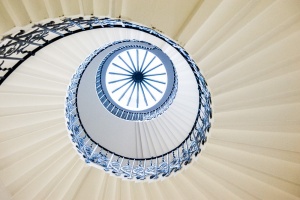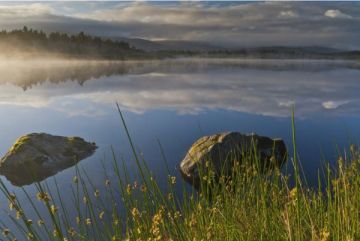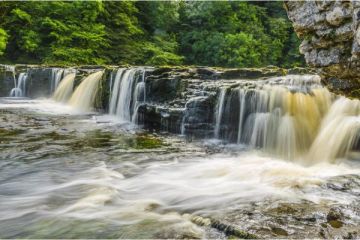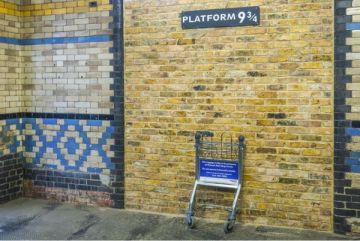
Queen's House, Greenwich
Palaces, residences, and other oddities associated with monarchs of Britain.
Banqueting House
Whitehall, SW1
Built by Inigo Jones for James I from 1619, it was the only major part of Whitehall palace to survive the fire of 1698. Contains a marvellous painted ceiling by Rubens.
Tube: Charing Cross, Embankment, Westminster
Buckingham Palace
The Mall, SW1
The London residence of the queen. Open for (pricey) tours of the State Rooms, including the Throne Room, from early August to early October. Details at www.royalcollection.org.uk. Tickets at the side entrance to the palace on Buckingham Palace Road. Info on Changing the Guard here.
Tube: St. James Park, Victoria
Royal Mews
Buckingham Palace Road, SW1
Just around the corner from the imposing facade of Buckingham Palace, the Mews is relatively quiet by comparison. It houses the royal vehicles, including carriages, horses, and equestrian gear. The 1910 Glass Coach is used for royal weddings, but the prize of the collection is the Gold State Coach (1762), used for coronations.
Tube: Victoria
Eltham Palace
Court Road, Eltham, SE9
One of the major Tudor palaces, Eltham has been badly damaged, and suffers from Art-Deco additions, but the Great Hall of 1480 is intact, with its remarkable hammer-beam roof. The modern additions are quite striking if Art-Deco is your cup of tea.
Rail: Eltham
Hampton Court Palace
East Molsey, Surrey, KT8
Begun by Cardinal Wolsey, who found it expedient to offer it to Henry VIII, this magnificent red-brick Tudor Palace is set in extensive formal and informal gardens beside the Thames. Visit the popular hedge maze, and the state apartments, with work by Christopher Wren and carvings by Grinling Gibbons. See if you can spot the ghost of Catherine Howard, Henry's fifth wife, who is said to haunt the palace.
Rail: Hampton Court (from Waterloo), or by waterbus from Westminster Pier, Richmond, or Kingston.
Kensington Palace
Kensington Gardens, W8
The royal residence here was redesigned by Christopher Wren for William and Mary in 1689. The State Apartments and the Court Dress Collection are open to the public, along with the sunken gardens. See the room where Queen Victoria was born, and paintings and furniture from the royal collection.
Tube: Queensway, Bayswater, High Street Kensington
Jewel Tower
Tube: Westminster
Dwarfed by the Palace of Westminster across the road, and by the looming bulk of Westminster Abbey to the rear, the Jewel Tower is the last remnant of a fortress built to house the crown jewels in safety. Not to be confused with the Jewel Tower at the Tower of London, where the Crown Jewels are on permanent display!
St James Palace
St James Street
St James Palace began as an Augustinian hospital, and later served as a female leper hospital. Henry VIII bought it and built a hunting lodge here in 1532. Henry enclosed 300 acres of land to serve as a royal hunting preserve; that preserve is now St James Park. The palace was the official London residence of the monarch from 1698 until Buckingham Palace took that role in the 19th century. However, St James remains the official London royal palace.
Tube: Green Park
Queen's House
Park Row, Greenwich, SE10 9NF
Built in 1616 by Inigo Jones, Queen's House is one of the few examples of Jones' influential work to survive. Now painstakingly restored, the highlights include the Cube Hall, superb frescoes on the bedroom ceiling, and the Tulip Staircase, the first known example of a cantilevered staircase design in Britain. Queen's House now houses the National Maritime Museum, Greenwich.
Tube: Cutty Sark
Clarence House
St James Palace, SW1 1BA
Elegant Clarence House stands beside St James Palace, and looks out on The Mall. Built by John Nash for Prince William (later William IV), Clarence House is the official London residence of the Prince of Wales and Duchess of Cornwall.
Tube: Green Park
Tower of London
Tower Hill, EC3N 4AB
Here's history! Based around a fortress begun by William the Conqueror, the Tower of London has been home, refuge, and prison to British monarchs for over 1000 years. It is not a single structure but a myriad of historic buildings linked to each other to create a wonderfully jumbled complex centred on the White Tower. The Crown Jewels are displayed in a special exhibition area, and you can see where some of the most famous names in British history were kept prisoner, and in some cases, beheaded.
Tube: Tower Hill



